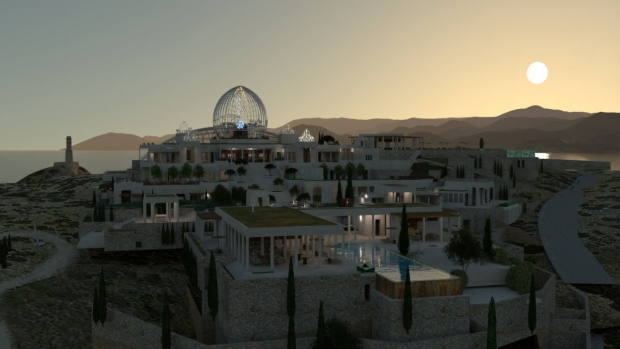The leading visual effects and animation company delivered 510 shots on 15 sequences for Rian Johnson and Netflix’s ‘Knives Out’ sequel, including the sprawling Greek island villa and titular signature glass monolith.
Contributing to the murderous intrigue of Rian Johnson and Netflix’s Glass Onion: A Knives Out Mystery was lead visual effects vendor DNEG, responsible for 15 sequences and a total of 510 shots under the watchful eyes of collaborators VFX Supervisor Sameer Malik and Executive Producer Philipp Wolf. The leading VFX and animation company’s digital contributions ranged from creating the onion-shaped glass monolith that provides the Knives Out sequel its title, producing a Greek island above and below the water, and the construction and destruction of a sprawling luxury villa.
“I would say the main difference from other shows I’ve worked on is that the requirement was for the visual effects to support the story,” notes Sameer Malik. “We needed to create environments which in no way overshadowed what had been actually shot for the movie. Every asset was built in a way that remained as close as possible to Rian’s vision and his previous films.”
DNEG worked with Production VFX Supervisor Giles Harding, who oversaw all visual effects work on the show. “Giles shot beautiful references that helped us a lot when it came to designing the major assets in the production,” notes Malik. “He was very precise when it came to data such as photogrammetry, and getting LiDAR scans for the island, villa, aerospace factory, apartment corridor, and Glass Onion.” Wolf enjoyed the collaboration. “From the get-go, we acknowledged that we are a team and had the same goal in mind bringing Rian’s vision to life!”
Concept art and reference were provided by the production team for all the major assets. “Giles also created three mood boards that reflected when the different scenes in the movie would take place and how the environments should look,” states Malik. “There were daytime shots, dusk/golden hour shots, and nighttime shots both with and without electricity. From there, our CG team was well-prepared for each sequence.”
Describing the need for additional visual research, Malik reveals, “For the Glass Onion, along with the concept art we received, we took reference from other glass building structures including the Syon Park Conservatory in London, the Glass Crust in Moscow, and the Dancing House in Prague. We used all the usual post-production software that DNEG utilizes. In terms of the techniques and workflows, these were adopted based on the Glass Onion rendering and look development requirements.”
One anticipated challenge was working with daytime exterior shots of the Glass Onion. According to Malik, “We had to find the right index of refraction and transmission in order to show the reflection of the environment. We tested the IOR [Index of Refraction] value under the different transmission values within the context of each shot to find the right balance.” He continues, “In the end we had to discount the physics a bit to find the impressive look we were going for with more reflection.”
Wolf adds, “Rendering was an issue. From a production perspective, the biggest challenge was to render such a reflective and refractive structure and ensure it properly sits in the different light situations of the provided plates.”
Over a post-production period of nine months, DNEG Montreal took the lead with assistance provided by DNEG Mumbai on assets and finals. “For the Greek island, we had practical plates from two different island locations,” explains Malik. “We used CGI to showcase these as one island, and created a full CG environment to show the whole island from inside the Glass Onion for the interior shots. The Manhattan backdrop also included some full CG shots in order to fulfil the narrative requirements. Based on Rian’s direction, we designed two full CG shots where the camera was positioned to showcase the island in the nighttime from the front and rear view. For the lighting schemes, we created three mood boards that showed how the Glass Onion should look in daytime shots, dusk/golden hour shots, and nighttime shots both with and without electricity.”
A special system was produced for the guest arrival scene. “We needed to replace the wooden dock with a glass dock and statues and create an automated system to lift it out of the water when the boat gets close to the island,” Malik says. “We also created the gas leak fire and Glass Onion explosion, including the destruction of the environment in the aftermath, which showcased the top of the villa burning with smoke and embers.”
“The shot of Benoit sitting on his balcony in Manhattan was surprisingly complex,” reveals Malik. “We needed it to look realistic without using the real Park Avenue environment backdrop.”
Noting each sequence had its own challenges, Malik states, “The Manhattan sequence was the most challenging. DNEG VFX Supervisor Giovanni Casadei, who is an environment expert, helped us with the scene under the guidance of our Creative Director, Chas Jarrett.” Wolf points out another extremely difficult shot. “For me, it was the full CG shot flying towards the back of the villa at night, showing all of the art pieces in the glass structures.”
Malik concludes by noting some personal highlights for viewers to see. “Probably, the full CG night shot from the back of the Island, right before all the guests walk into the atrium,” he says. “Or when the lights are switched off and we see Andi running towards the Glass Onion. That shot is so cool because we get to showcase the Glass Onion without electricity and just the infinity cube blue light.”
Wolf, a fan of the destruction that unfolds, concludes, “For me, it’s the explosion shot. Recreating a hydrogen inspired explosion within a glass structure was such a highlight.”


























